Abstract
Falling objects from façades often lead to serious accidents, which has become a technical problem to be solved urgently. This paper established a database of potential safety hazard of falling objects from façades via the statistics of detection façades in Shanghai. Some detailed insufficiencies and swelling defects were analyzed. A risk assessment system of falling objects from façades was established using the Fault Tree Analysis (FTA) method. The weight coefficient was determined by the Analytic Hierarchy Process (AHP). The beta distribution was used to fit the probability distribution of the occurrence probability of the elementary risk event. Based on the Monte Carlo model, the risk of falling objects from façades was assessed. A probability distribution of the risk probability of falling objects from façades and the importance of elementary risk factors were obtained. Some risk control measures of falling objects from façades were proposed.
1. Introduction
Falling objects cause a great hazard and psychological insecurity to residents, especially for megacities with many skyscrapers. Data show that safety accidents caused by falling objects have become the most major casualty accidents except traffic accidents [1]. There are three sources of falling objects. One is the thrown objects from residents; the second is spare objects on the windowsill or balcony; the third is falling objects from façades and their ancillary facilities. Among them, the thrown objects from residents as well as the spare objects on the windowsill or balcony can be effectively prevented through safety education for residents and the relevant legislation. There is no idea for the risk control of falling objects from façades because of detail insufficiencies caused by improper design or construction and the defects caused by materials deterioration, although some measures (adhesive, anchor bolt, and interface agent) have been taken to prevent the façades falling off.
Façades have diverse types and complex details, and their materials are of varying quality. Façades with different functions and materials have different details, as shown in Figure 1 [2,3] and Figure 2 [4]. Generally, the façade is composed of substrate (external building wall), thermal insulation coat (with the function of thermal insulation), and finish coat. The materials of the substrate are concluded concrete, sintered brick, hollow brick, aerated block, etc. Part of the façades with thermal insulation function are provided with an external thermal insulation coat. A cement mortar anti-cracking coat with glass fiber mesh or steel wire mesh should be set. A screed-coat should be set on the substrate to ensure a flat surface so that the insulation plates such as, expanded polystyrene (EPS) plate, extruded polystyrene (XPS) plate and rock wool plate, can be firmly adhered [5]. In addition, inorganic thermal insulation mortar (ITIM) [6], rubber powder poly-phenyl granule (RPPG) [7], and other slurry insulation materials are also common. The materials of the finishing coat include: plastic paint, adhesive ceramic tiling, granitic plaster, etc. Some façades with external thermal insulation composite system (ETICS) are provided with anchor bolts to increase the safety of the insulation coat. However, due to the lack of theoretical support and inadequate construction quality, detail insufficiencies of façade are often caused, such as insufficient interlayer bonding strength, detail insufficiency of glass fiber mesh, insufficient thickness of crack resistant mortar, insufficient number of anchor bolts, etc.
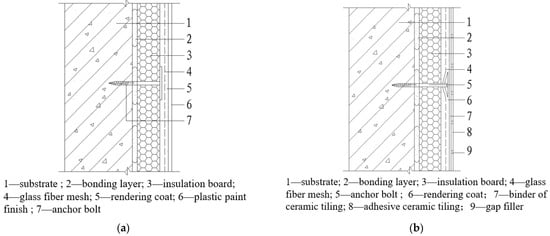
Figure 1.
Details of insulation plate ETICS with thin plastering. (a) Pasting insulation plate with plastic paint finish. (b) Pasting insulation plate with adhesive ceramic tiling.
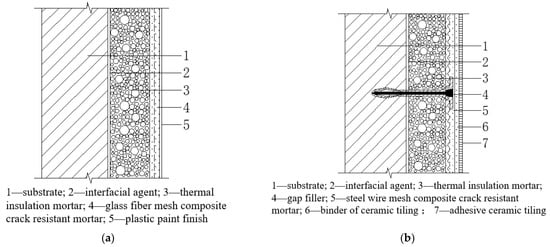
Figure 2.
Details of thermal insulation mortar ETICS. (a) Thermal insulation mortar ETICS with plastic paint finish. (b) Thermal insulation mortar ETICS with adhesive ceramic tiling.
The façade works as a barrier against external aggressions such as wind, rain, hail, solar radiation, and so on. Under the actions of wind pressure [8], temperature change [9], wet–dry cycle [10,11], bioerosion [12], freeze–thaw cycle [13], and object impact [14], façades deteriorated continuously with the growth of building age. The façades showed water stains, cracks, swelling, and even falling off. These factors influencing the deterioration of façade interact and couple with each other. The deterioration mechanism of façade is complex, and the trigger mechanism of falling off is not clear. Due to these characteristics, the risk factors of falling objects from façades are difficult to be identified.
The technical problem demanding prompt solution of falling objects from façades seriously threatens the safety of people’s lives and property. In order to eliminate the potential safety hazard of falling objects from façades, many scholars have conducted in-depth research on an automatic inspection method of façades, sensor technology of defect detection, and a segmentation algorithm of defect detection [15,16]. These efforts enriched the means of façade detection. In the actual detection of façades, the pull-off test is used to test the tension bond strength of façade [5,17]. The details of glass fiber mesh and the number of anchor bolts were detected by local breakage. The thickness of anti-cracking mortar was measured by the core drilling sampling method. The infrared thermography method [18] combined with the knock echo method [19] was used to detect the swelling defects of façades. However, studies on the influences of detection results on the safety of façades are limited. Therefore, it is difficult to get accurate and targeted risk treatment measures and repair design for façades.
This paper accumulated knowledge from previous detection cases and established a database of potential safety hazard of falling objects from façades. Some influencing factors of façade deterioration and trigger of falling objects were analyzed. A risk assessment method of falling objects from façades was proposed. Some key risk factors of falling objects from façades were identified. It is conducive to finding potential safety hazards in advance, and is an effective way to curb the occurrence of falling objects accidents.
2. Risk Identification Based on the Case Database
2.1. Data Analysis in the Case Database
A large number of detection projects about building façades in Shanghai have been carried out. Detailed investigations and on-site testing were carried out for each case, especially for swelling defects and detail insufficiencies. This paper collected a total of 224 façade detection cases from Shanghai Research Institute of Building Sciences Co., Ltd., and the detection contents included: completion time, types of building structures, substrate materials, types of external thermal insulation composite systems (ETICS), types of finish coats, swelling defects, detail insufficiencies, etc. A case database of the risks of falling objects from façades was established after statistical analysis.
- (1)
- Statistics based on building completion time
Generally, with the increase of building service age, the durability of façade degrades gradually, and the probability of falling objects from façades increases. Therefore, the building service age is a key factor affecting the safety of façade. As shown in Figure 3, among these detection buildings, the earliest completion year is 1906, and the latest is 2017. Most of the buildings were constructed after 2000, and the largest number of buildings were constructed in 2011–2015, totaling 63.
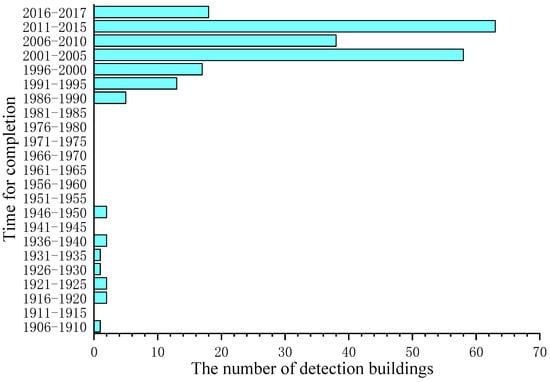
Figure 3.
The completion times of detection buildings.
- (2)
- Statistics based on the types of finish coats
Statistical analysis was carried out on the detection results of the façades of 224 building. The plastic paint finish, adhesive ceramic tiling, and aluminum–plastic composite panel are the three largest proportion of finish coats in all cases, accounting for 51.1%, 32.3%, and 9.9%, respectively, as shown in Figure 4. Different types of finishing coats are used for building façades in different periods. As shown in Figure 5, before 2001, adhesive ceramic tiling was widely used in the finish coats. After 2002, plastic paint finish was gradually popularized. After 2012, the adhesive ceramic tiling was gradually withdrawn from the market and replaced by plastic paint finish. For some historical and commercial buildings, stone finish and aluminum–plastic composite panel were used. The mosaic finish and exposed aggregate finish were also used in a few buildings.
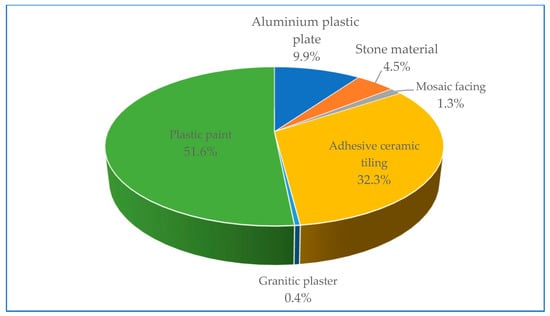
Figure 4.
Proportion of various types of building finishes.
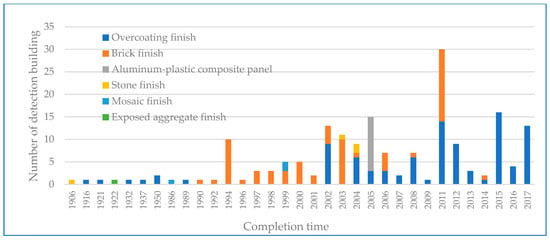
Figure 5.
Type of façade finish at different completion times.
- (3)
- Statistics based on the type of external thermal insulation composite system
Among the 224 detected buildings, 113 buildings, accounting for 50.4% of the total cases, adopted the ETICS. Due to the influence of economic development, technological progress, policy changes, and other factors, different ETICS with specific performance appeared successively. The risk of falling objects from façades is closely related to the type of ETICS. Figure 6 lists the proportion of various type of ETICS. The three types with largest proportion are ITIM-ETICS, EPS-ETICS, and rock wool board-ETICS, accounting for 28.3%, 24.8%, and 19.5%, respectively.
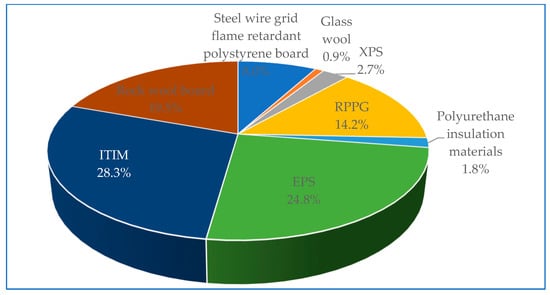
Figure 6.
Proportion of each type of ETICS.
A different type of ETICS was used for external wall thermal insulation coats in different periods. As shown in Figure 7, before 2004, most of the buildings did not have thermal insulation measures. The polystyrene plate ETICS was mainly used in 2005–2009. Since 2011, a large number of ITIM-ETICS has been used because of its good fire-resistant performance.
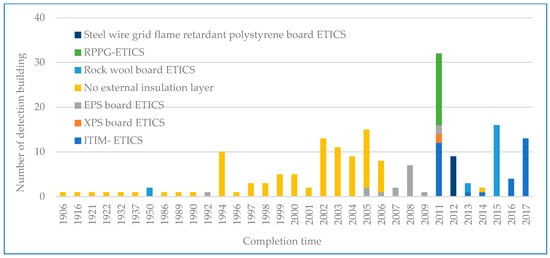
Figure 7.
Type of ETICS at different completion times.
- (4)
- Statistics based on the type of falling objects
Among the 224 detected buildings, the façades of 160 buildings appeared to be peeling off. As shown in Figure 8, the finishing coat occupies the largest proportion of 144 cases, accounting for 90%. ETICS accounts for 9%. For the 144 cases, the proportion of different types of finishing coat was counted as shown in Figure 9. Thereinto, plastic paint finish accounted for the largest proportion of 52%. Posteriorly, the adhesive ceramic tiling accounted for 36%.
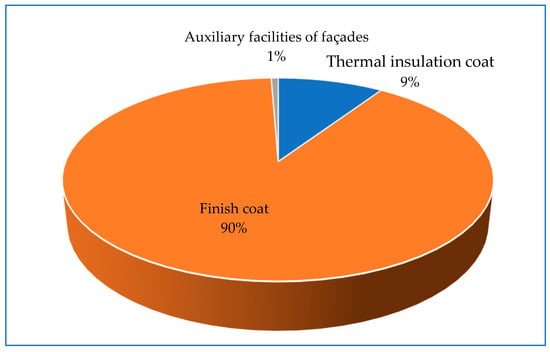
Figure 8.
Proportion of the types of façades appeared falling objects.
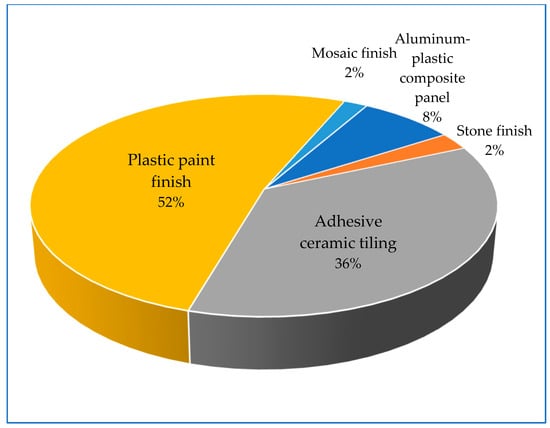
Figure 9.
Proportion of the thermal insulation materials used in façades appearing with falling objects.
2.2. Statistical Analysis of Façade Defects and Insufficiencies
- (1)
- Statistics based on the swelling defects
Among the 224 detected buildings, the finishing coats of 166 buildings appeared to have a swelling defect. Among them, plastic paint finish accounted for the largest proportion of 58%, followed by adhesive ceramic tiling, accounting for 40%, as shown in Figure 10. The thermal insulation coats of 51 buildings appeared to have a swelling defect. Among them, ITIM-ETICS and rock wool plate ETICS both account for 37%, and RPPG-ETICS account for 24%, as shown in Figure 11.
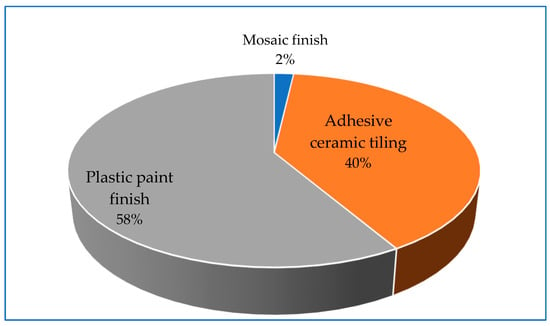
Figure 10.
Proportion of the types of finishes with swelling defect.
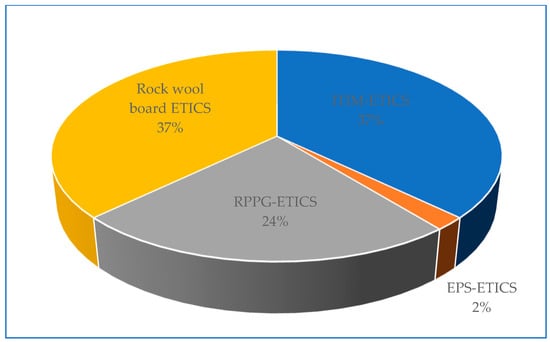
Figure 11.
Proportion of types of ETICSs with swelling defect in the insulation layer.
- (2)
- Statistics based on the detail insufficiencies
- Statistics based on the bond strength of façades
The bond strength of façade finishing coat for 59 buildings was tested, and 33 cases could not reach the demands. The rock wool plate ETICS accounted for the largest proportion, 49%. The RPPG-ETICS and ITIM-ETICS accounted for 33% and 18%, respectively, as shown in Figure 12.
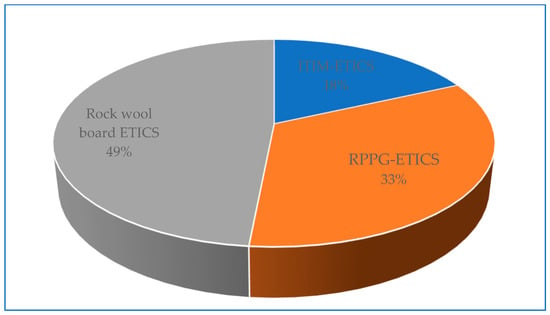
Figure 12.
Proportion of types of ETICS with insufficient bonding strength.
- 2.
- Statistics based on the other detail insufficiencies
For the detail insufficiencies of 125 detected buildings, 102 buildings have various detail insufficiencies, accounting for 81.6%; 50% of them are the detail insufficiency of glass fiber mesh. The insufficient number of anchor bolts and the insufficient thickness of crack resistant mortar account for 26% and 24%, respectively, as shown in Figure 13.
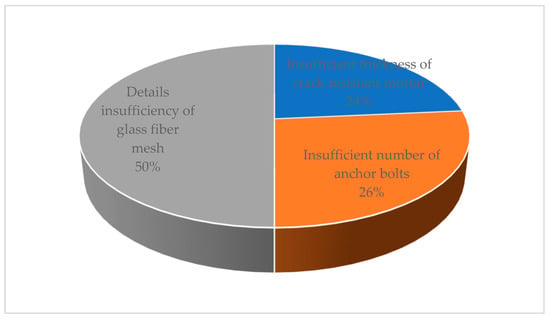
Figure 13.
Proportion of detail insufficiencies of façade.
Figure 14 illustrates the proportions of various detail insufficiencies in the total number of detected buildings. All the detected glass fiber meshes and 90.0% of the anchor bolts did not meet their demands; 54.5% of the crack resistant mortar did not reach specified thickness.
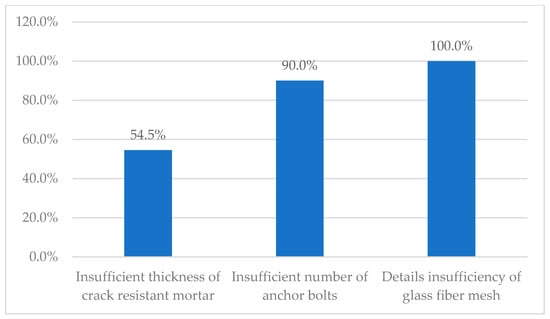
Figure 14.
Proportion of detail insufficiencies in total number of detection buildings.
To sum up, the main risk factors of falling objects from façades are the detail insufficiencies caused by improper design or construction and the swelling defects caused by material deterioration. The detail insufficiencies for finish coat include insufficient bonding strength of finish coat, detail insufficiency of glass fiber mesh, and insufficient thickness of crack resistant mortar. The detail insufficiencies for thermal insulation coat include insufficient number of anchor bolts, insufficient bonding strength of thermal insulation coat, and insufficient bonding area of thermal insulation coat. The swelling defect may appear in the finish coat and thermal insulation coat.
3. The Method of Risk Assessment Based on Monte Carlo Method
The Monte Carlo method [20], also known as stochastic sampling method or statistical test method, is a numerical simulation method for risk probability analysis through a large number of stochastic samples. When the probability distribution of stochastic variable is known, an assessment index of a project can be obtained by the state function substituted a set of random numbers generated by sampling of stochastic variable. Taking enough sampling, a probability distribution of a project assessment index can be obtained, thus providing a reference for the feasibility of the project [21].
3.1. The Establishment of Monte Carlo Model
- (1)
- Hierarchy calculation of risk coefficient
The Analytic Hierarchy Process (AHP) [22,23] was developed by Thomas L. Saaty in the 1970s. The AHP decomposes a total index of a research object into various components, and then forms a logical hierarchical structure. Comparing elements in each level, superposing and synthesizing elements at various levels, a risk assessment system can be established. The Fault Tree Analysis (FTA) [24] method, which can form a multi-level risk transmission path from top event, intermediate event, to elementary event, was taken as the basis of assessment system.
Based on the FTA assessment system, according to the AHP, the risk coefficients of elementary events are transferred upward to calculate a risk probability of the top event. For elementary events, this paper adopts the failure probabilities as their risk coefficients to conduct reliability analysis according to the Posbist Reliability Theory (PRT) [25]. Because of different levels of importance of each event, a risk coefficient of upper event was calculated by the products of the risk coefficients and weight coefficients of the lower event.
Let be a set of risk coefficients of the lower events. Let be a set of weight coefficients. Therefore, a risk coefficient of an upper level event is:
where and are respectively the risk coefficient and weight coefficient of the ith event in the same branch. In addition, the risk coefficients of elementary events are calculated based on the case database, and the weight coefficients are calculated by the AHP.
- (2)
- Determination of the weight coefficient
The fuzzy consistency judgment matrix (FCJM) is superior to the other judgment matrices to calculate the weight coefficients of the judgment matrix [26]. Three solutions, square root method, summation by row and normalization method, and ranking method based on the relationship between the elements of FCJM and weights were compared and analyzed. The third method has the highest resolution to calculate the weight coefficient [27].
- 1.
- Establishment of the FCJM
Comparing the importance of the elements in a level for elements of previous level, the FCJM can be obtained. It reflects the consistency of people’s thinking and judgment. Assuming that elements (a1, a2, a3…an) in a level are related to the element C of previous level, the FCJM can be expressed as [28]:
where lij is the numerical scaling which represents an ambiguous relationship between ai and aj, when ai and aj influence upper element C. A 0.1–0.9 numerical scaling method is used to quantitatively express ambiguous relationship, as shown in Table 1.

Table 1.
The 0.1–0.9 quantity scale.
If elements a1, a2, a3, and a4 have a judgment matrix R relative to the element of previous level:
The FCJM with the scale has the following properties:
- 2.
- Calculation of a weight coefficient of the FCJM
Based on the relationship between the elements and weights of FCJM, the weight coefficients are calculated as follows [29]:
where the smaller a is, the larger the difference of weight is, indicating that decision-makers attach great importance to the differences between elements, in the paper.
- (3)
- Fittings of risk coefficients of elementary events by beta distribution
In most cases, a probability distribution of elementary event is difficult to determine. However, a probability curve of risk coefficient shows a single peak shape distribution, which can be fitted by a beta distribution directly [30]. The probability density function, mathematical expectation and variance of beta distribution are shown in Equation (6), Equation (7), and Equation (8), respectively. When the value of α + β is constant, the smaller α is, the smaller mathematical expectation is, and the probability distribution curve tends to 0, otherwise it tends to 1. With the increase of α + β, the variance decreases, and the probability distribution curve tends to concentrate.
where, .
Considering the characteristics of beta distribution, the α + β is taken as the total number of cases, and the α is taken as the number of risk events. The beta distribution has the following advantages and characteristics:
- The value interval of beta distribution ranges from 0 to 1, which is in line with the probability range of risk event.
- The mathematical expectation of the beta distribution represents the mean of the probability of a risk event.
- In subsequent works, the case database can be continuously enriched from different channels. This process follows Bernoulli distribution which is conjugate with beta distribution. Therefore, the beta distribution will be updated with the expansion of the case database, and the fitting failure probability will become more accurate.
3.2. Application of Monte Carlo Method
The Monte Carlo model established in this paper can be used to assess the security condition of façade of a building or some buildings in a region, and identify the key risk factors of falling objects from façades. Therefore, some targeted risk control measures can be developed.
- (1)
- Integral risk assessment
Based on the risk assessment system of falling objects, input the risk coefficients of a set of elementary events to obtain an output of the integral risk coefficient of top event. After running 106 times, a probability distribution of risk coefficient of top event can be obtained. The risk of falling objects can be assessed as a whole.
- (2)
- Diagnosis of risk factor importance
The Monte Carlo method has special advantages. It can express many influences or relationships through sensitivity analysis. In addition, only the relationship between the output and the input data needs to be analyzed, avoiding the complex internal operations. The risk importance was diagnosed using the importance analysis of FTA in this paper. The changing value of integral risk probability caused by 10% increase of the probability of the ith elementary event was taken as the importance of the risk event.
- (3)
- Targeted risk control measures
The risk factors of falling objects from façades were identified via the risk assessment. The probabilities of risk events can be reduced taking targeted prevention efforts. In view of the collected cases, tracing the root causes, the occurrence mechanism is analyzed. Some measures such as inspection and management should be taken for the important risk factors.
3.3. Risk Assessment of the Falling Objects from Façades
- (1)
- Risk assessment system of the falling objects from façades
Here we make statistics on the risk factors of falling objects from façades, and analyze the logical relationship among them. The analytic risk hierarchy and statistical results are shown in Table 2. A risk assessment system of the falling objects from façades is established through FTA, as shown in Figure 15.

Table 2.
Hierarchical analysis and statistics of the risk of falling objects from façade.
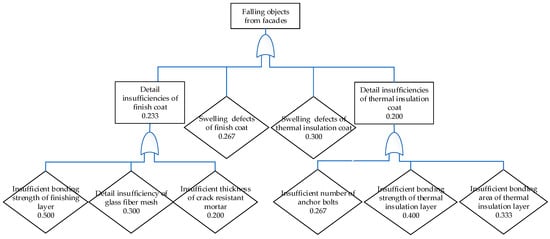
Figure 15.
Risk assessment system of falling objects from façade.
- (2)
- The risk probability distributions of elementary events
The elementary risk events of falling objects from façades are obtained using AHP as shown in Table 3. The α is taken as about 6 times of the number of elementary events as shown in Table 3 because the number of façade detection cases of Shanghai Research Institute of Building Sciences Co., Ltd. accounts for about 1/6 of all façade detection cases in Shanghai. The α + β was determined according to the total number of residential buildings on the website of Shanghai Lianjia Real Estate Brokerage Co., Ltd., about 400,000. The risk probability distributions of elementary events are shown in Figure 16.

Table 3.
Probability distribution parameters of elementary risk events of falling objects from façade.
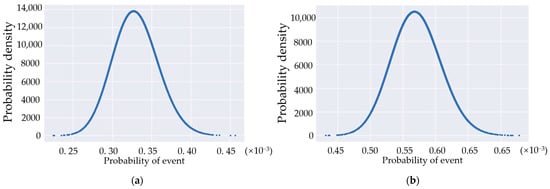
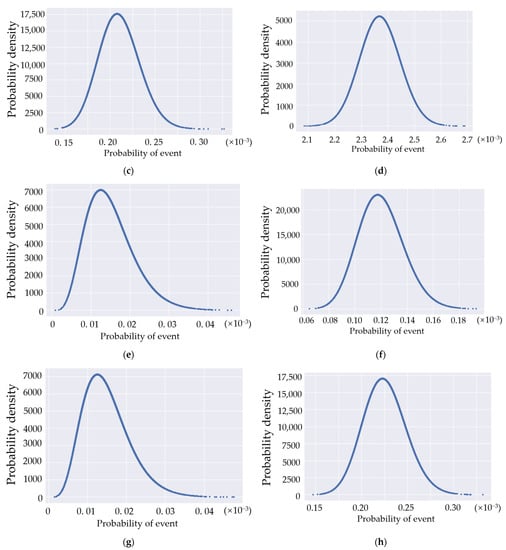
Figure 16.
Risk coefficient distributions of elementary events. (a) Insufficient bonding strength of finishing layer. (b) Detail insufficiency of glass fiber mesh. (c) Insufficient thickness of crack resistant mortar. (d) Swelling defect of finishing layer. (e) Insufficient number of anchor bolts. (f) Insufficient bonding strength of thermal insulation coat. (g) Insufficient bonding area of thermal insulation coat. (h) Swelling defect of thermal insulation coat.
- (3)
- Weight coefficients calculated by AHP
Based on 0.1–0.9 numerical scaling methods, the FCJM of risk factors at each level is obtained as follows:
The weight coefficients calculated by AHP are as follows:
- (4)
- Risk assessment of falling objects from façades
- Risk probability distribution of falling objects from façades
Starting from the elementary events, a product of the risk coefficient and the weight coefficient at the lower level was taken as a risk coefficient at the upper level, which was superimposed level by level, and a risk probability of the top event was obtained. Programming with Python, running 106 times, a risk probability distribution of falling objects from façades is shown in Figure 17. The risk probabilities are mainly distributed between 7.5 × 10−4 and 8.5 × 10−4, and the most likely risk probability is 8.0 × 10−4.
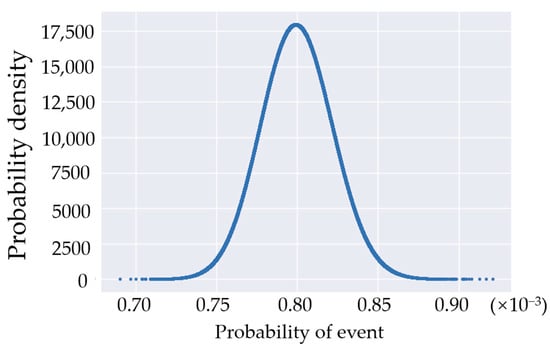
Figure 17.
Risk probability distribution of falling objects from façades.
- 2.
- Importance analysis of elementary risk factors
In the case database, the number of each elementary risk event was increased by 10%, respectively, and a variation of the risk probability of top event caused by the increase was calculated. After 106 Monte Carlo simulations, a variation of risk probability of the top event was obtained as the importance of the elementary event, as shown in Table 4. the elementary risk factors are ranked from most important to least important: swelling defect of finish coat, swelling defect of thermal insulation coat, detail insufficiencies of glass fiber mesh, bond strength insufficiency of finish coat, bond strength insufficiency of thermal insulation coat, insufficient thickness of crack resistant mortar, insufficient bond area of thermal insulation coat, and insufficient number of anchor bolts.

Table 4.
The importance of the elementary events.
- 3.
- Risk control measures of falling objects from façades
Through Monte Carlo analysis of the risk of falling objects from façades, the risk probability was assessed. According to the risk probability distribution of top event and the risk importance of elementary events, reasonable risk disposal measures were taken for different situations as follows:
- For the façades where falling objects appeared, some measures such as posting notice, pulling warning lines, or building protective sheds should be conducted in time
- For the façades with swelling defects, the development of swelling defects shall be monitored regularly. In case of serious swelling defects, an early warning for the falling objects shall be issued in time.
- Daily inspection and maintenance shall be strengthened for façades without swelling defect but with detail insufficiencies.
4. Conclusions
The Monte Carlo method was used to assess the risk of falling objects from façades, based on the database of the façades detection cases in Shanghai. Some key risk factors were identified by the risk importance of falling objects from façades. Some conclusions were obtained:
- (1)
- Some statistical analyses were carried out on the detection results of 224 building façades, the main risk factors of falling objects from façades are the detail insufficiencies caused by improper design or construction and the swelling defects caused by materials deterioration.
- (2)
- The risk coefficients of elementary events are the input variables of Monte Carlo model, which were fitted by beta distribution according to their unimodal characteristics and value range. Beta distribution as the conjugate of the Bernoulli distribution can easily obtain the posterior distribution of risk coefficients with the continuous enrichment of data. The analysis results can be updated and optimized in real time.
- (3)
- The elementary risk factors ranking from most important to least important are as follows: swelling defect of finish coat, swelling defect of thermal insulation coat, detail insufficiency of glass fiber mesh, bond strength insufficiency of finish coat, bond strength insufficiency of thermal insulation coat, insufficient thickness of crack resistant mortar, insufficient bond area of thermal insulation coat, and insufficient number of anchor bolts.
- (4)
- A risk assessment system which can quantify the risk of falling objects from façades was established in the paper. However, the specific meaning of risk probability calculated by the risk assessment system need to be further studied. The risk probability thresholds of high, medium, and low risks should be further determined.
Author Contributions
Formal analysis, D.Z.; investigation, F.M.; resources, D.Z.; data curation, X.C.; writing—original draft preparation, X.C.; writing—review and editing, Z.W. and L.J.; supervision, D.Z. and L.J.; project administration, F.M.; funding acquisition, Z.W. All authors have read and agreed to the published version of the manuscript.
Funding
This work was financially supported by National Key R&D Program of China (No. 2021YFF0602003), and Program of Shanghai Subject Chief Scientist (B type) (No. 21XD1434100), all of which are gratefully acknowledged.
Data Availability Statement
The data presented in this study are available on request from the corresponding author. The data are not publicly available as the data also forms part of an ongoing study.
Acknowledgments
The author would like to thank the journal’s reviewers for providing helpful comments, and the staff for careful and professional work.
Conflicts of Interest
The authors declare no conflict of interest.
References
- Pauls, J. Safety standards, requirements, and litigation in relation to building use and safety, especially safety from falls involving stairs. Saf. Sci. 1991, 14, 125–154. [Google Scholar] [CrossRef]
- Kvande, T.; Bakken, N.; Bergheim, E.; Thue, J.V. Durability of ETICS with Rendering in Norway—Experimental and Field Investigations. Buildings 2018, 8, 93. [Google Scholar] [CrossRef]
- JGJ 144-2019; Technical Specification for External Thermal Insulation on Walls. China Architecture & Building Press: Beijing, China, 2019. (In Chinese)
- JG 158-2016; External Thermal Insulating Rendering Systems Made of Mortar with Mineral Binder and Using Expanded Polystyrene Granule as Aggregate. China Standard Quality Inspection Press: Beijing, China, 2016. (In Chinese)
- ETAG. Guideline for European Technical Approval of External Thermal Insulation Composite Systems (ETICS) with Rendering; EOTA: Bruxelles, Belgium, 2013. [Google Scholar]
- Guo, X.H.; Li, Z.; Yang, Z.Q. Energy Conservation Study on Integrated Thermal Insulation Buildings Made of Glazed Hollow Beads Mortar. Adv. Mater. Res. 2011, 295, 907–911. [Google Scholar] [CrossRef]
- Becker, P.F.B.; Effting, C.; Schackow, A. Lightweight thermal insulating coating mortars with aerogel, EPS, and vermiculite for energy conservation in buildings. Cem. Concr. Compos. 2022, 125, 104283. [Google Scholar] [CrossRef]
- European Organization for Technical Approvals. External Thermal Insulation Composite Systems with Rendering (EOTA ETAG004—2000); EOTA: Bruxelles, Belgium, 2000. [Google Scholar]
- Ximenes, S.; De Brito, J.; Gaspar, P.L.; Silva, A. Modelling the degradation and service life of ETICS in external walls. Mater. Struct. 2015, 48, 2235–2249. [Google Scholar] [CrossRef]
- Pereira, C.; de Brito, J.; Silvestre, J.D. Contribution of humidity to the degradation of façade claddings in current buildings. Eng. Fail. Anal. 2018, 90, 103–115. [Google Scholar] [CrossRef]
- Ferreira, C.; Barrelas, J.; Silva, A.; de Brito, J.; Dias, I.S.; Flores-Colen, I. Impact of Environmental Exposure Conditions on the Maintenance of Facades’ Claddings. Buildings 2021, 11, 138. [Google Scholar] [CrossRef]
- Barreira, E.; De Freitas, V.P. External Thermal Insulation Composite Systems (ETICS): An Evaluation of Hygrothermal Behaviour; Springer: Cham, Switzerland, 2015. [Google Scholar]
- Maděra, J.; Kočí, V.; Doleželová, M.; Čáchová, M.; Jerman, M.; Černý, R. Influence of weather-affected material characteristics on appearance of freeze/thaw cycles in building envelopes. In AIP Conference Proceedings 2017; AIP Publishing LLC: Melville, NY, USA, 2017; Volume 1866, p. 040023. [Google Scholar]
- Norvaišienė, R.; Buhagiar, V.; Burlingis, A.; Miškinis, K. Investigation of mechanical resistance of external thermal insulation composite systems (ETICS). J. Build. Eng. 2020, 32, 101682. [Google Scholar] [CrossRef]
- Chew, M.Y. Façade inspection for falling objects from tall buildings in Singapore. Int. J. Build. Pathol. Adapt. 2021; ahead-of-print. [Google Scholar] [CrossRef]
- Chew, M.Y.L.; Gan, V.J.L. Long-Standing Themes and Future Prospects for the Inspection and Maintenance of Façade Falling Objects from Tall Buildings. Sensors 2022, 22, 6070. [Google Scholar] [CrossRef] [PubMed]
- Malanho, S.; do Rosário Veiga, M. Bond strength between layers of ETICS–Influence of the characteristics of mortars and insulation materials. J. Build. Eng. 2020, 28, 101021. [Google Scholar] [CrossRef]
- Balaras, C.; Argiriou, A. Infrared thermography for building diagnostics. Energy Build. 2002, 34, 171–183. [Google Scholar] [CrossRef]
- Dai, P.Y. Study on Nondestructive Testing of Building Exterior Wall Tiles by Beating Method; National University of Kaohsiung: Kaohsiung, Taiwan, 2008. (In Chinese) [Google Scholar]
- Metropolis, N.; Rosenbluth, A.W.; Rosenbluth, M.N.; Teller, A.H.; Teller, E. Equation of State Calculations by Fast Computing Machines. J. Chem. Phys. 1953, 21, 1087–1092. [Google Scholar] [CrossRef]
- Rubinstein, R.Y.; Kroese, D.P. Simulation and the Monte Carlo Method; John Wiley & Sons: Hoboken, NJ, USA, 2016. [Google Scholar]
- Golden, B.L.; Wasil, E.A.; Harker, P.T. The Analytic Hierarchy Process; Applications and Studies: Berlin/Heidelberg, Germany, 1989; Volume 2. [Google Scholar]
- Vaidya, O.S.; Kumar, S. Analytic hierarchy process: An overview of applications. Eur. J. Oper. Res. 2006, 169, 1–29. [Google Scholar] [CrossRef]
- Xing, L.; Amari, S.V. Fault tree analysis. In Handbook of Performability Engineering; Springer: London, UK, 2008; pp. 595–620. [Google Scholar]
- Dubois, D. Fuzzy Sets and Systems—Theory and Applications; Academic Press: Cambridge, MA, USA, 1980. [Google Scholar]
- Zhang, J.J. Fuzzy analytical hierarchy process. Fuzzy Syst. Math. 2000, 14, 80–88. (In Chinese) [Google Scholar]
- Zhang, J.J. Comparison of three ranking methods for the fuzzy consistent judgement matrix. Syst. Eng. Electron. 2003, 25, 1370–1372. (In Chinese) [Google Scholar]
- Gao, J.-P.; Xu, Z.-S.; Liu, D.-L.; Cao, H.-H. Application of the Model based on Fuzzy Consistent Matrix and AHP in the Assessment of Fire Risk of Subway Tunnel. Procedia Eng. 2014, 71, 591–596. [Google Scholar] [CrossRef]
- Lu, Y.J. Weight calculation method of fuzzy analytical hierarchy process. Fuzzy Syst. Math. 2002, 16, 79–85. [Google Scholar]
- Leng, W.M. Reliability Analysis and Design Theory of Foundation Engineering; Central South University Press: Changsha, China, 2000. (In Chinese) [Google Scholar]
Disclaimer/Publisher’s Note: The statements, opinions and data contained in all publications are solely those of the individual author(s) and contributor(s) and not of MDPI and/or the editor(s). MDPI and/or the editor(s) disclaim responsibility for any injury to people or property resulting from any ideas, methods, instructions or products referred to in the content. |
© 2023 by the authors. Licensee MDPI, Basel, Switzerland. This article is an open access article distributed under the terms and conditions of the Creative Commons Attribution (CC BY) license (https://creativecommons.org/licenses/by/4.0/).